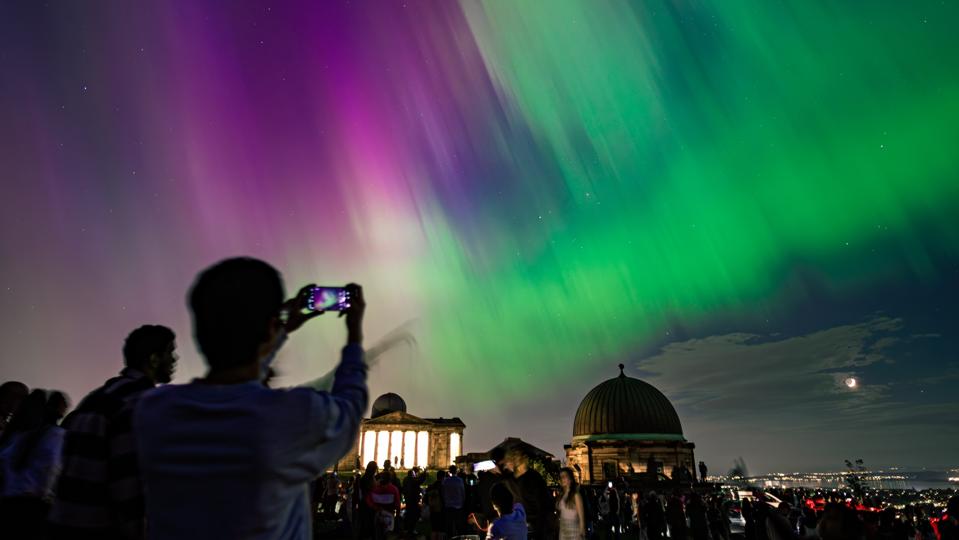Want to photograph the Northern Lights, the aurora borealis? There are forecasts that the phenomenon will be visible as far south as mid-northern latitudes in the U.S. and Europe on Wednesday, April 16, in the wake of a few nights of intense geomagnetic activity.
Happily, capturing the aurora using a phone and camera has never been easier. Here’s how to make the most of your camera or smartphone, with advice from experts.
Northern Lights Tonight: How To Take Photos Of The Aurora With A Phone
Thanks to advancements in smartphone sensors, a modern-day smartphone — even one a few years old — is often more than enough to capture aurora. The key is in knowing how to set it up properly.
1. Turn The Flash Off
You should always disable the flash on your phone at night — it’s useless and will ruin your own photos and everyone else’s.
2. All Phones: Shoot In RAW
By using the RAW format, more data is collected. “If your iPhone allows it, shoot your photos in RAW format instead of JPEG. RAW photos preserve more details and provide greater flexibility for editing your photos later on,” said Antony Willets, photography expert at Max Spielmann, in an email. On iPhone, go to Settings > Camera > Formats, then enable Apple ProRAW. Tap RAW in the Camera app before shooting.
3. Use Your Primary Lens
A wide-angle shot will get more of the aurora in, but it will make it look far dimmer. The standard, default lens on your phone is by far the best quality — so use it. For the same reason, don’t bother using the selfie camera.
4. iPhone: Use ‘Night Mode’
This is what to use in low light. Tap the Night Mode icon, then extend the exposure time using the slider. The longer the exposure, the more detail your phone captures. “The iPhone’s Night Mode is usually between one and three seconds, but for the Northern Lights, you want this to be as long as possible,” said Willets.
5. All Phones: Play With Exposure
Aurora hunting in light-polluted areas? Adjust your exposure settings manually to avoid over-exposing and to improve contrast. On an iPhone, tap the screen and drag your finger down to reduce exposure or access the Night Mode menu to tweak the plus-minus settings. It will help preserve details in the aurora.
6. Android Phones And Cameras: Go Manual
Android’s Pro Mode will allow you to manually control settings. Here’s what to go for — which also applies to any manual DSLR or mirrorless camera.
- Exposure time: up to 30 seconds (but experiment).
- Aperture: Set to the lowest possible (f/2.8 or below if your phone allows adjustment).
- ISO: Set high (around ISO 3200-6400) to allow more light in.
7. All Phones: Use A Tripod
Holding a phone up to the sky to take a photo of the aurora just about works — but it does degrade your image more than you think. “If your iPhone detects trembles or shakes — such as if you’re trying to hold it still for a long time — your maximum exposure will be about 10 seconds,” said Willets. Put it on a tripod, and the iPhone will suddenly allow you to take 30-second exposures, which is recommended if the aurora is faint. “We recommend using a tripod — you’ll want to place it on an even and steady surface—- and your long exposure time should extend to between 25 and 30 seconds,” said Willets. A longer exposure will bring out greens and reds invisible to the naked eye.
8. Try A Video
Remarkably, a phone can shoot video of the aurora — if you tweak the settings just right. “Put your video settings on the iPhone down to HD and 30 frames a second, and it’s way more sensitive to the Northern Lights,” said Tom Kerss, author of The Northern Lights: The Definitive Guide to Auroras, in an interview. “Shooting at a lower resolution and a lesser frame rate increases sensitivity in low light — but don’t move the phone too quickly, or it will get very smudgy,” said Kerss. “Slower movements will look better.”
9. Process With Care
A surefire to make your friends green with envy is to make the aurora look as colorful as possible, right? Wrong. Overdo it, and your image can easily look over-processed and unreal.
Northern Lights: Where And When To See Aurora Tonight
Wednesday afternoon saw the Kp index — which provides a rough guide to the intensity of aurora displays — reach 7, which equates to a G3-class geomagnetic storm (the strongest being G5). That could mean “very active” aurora, according to NOAA, that’s possible to see from the northern edge of the United States.”
U.S. states that could potentially see the aurora include Alaska, Washington, northern Oregon, northern Idaho, Montana, Wyoming, North Dakota, South Dakota, Minnesota, northern Iowa, Wisconsin, northern Illinois, Michigan, New York, Vermont, New Hampshire and Maine.
Wishing you clear skies and wide eyes.

